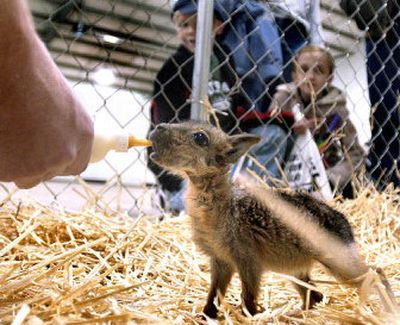Patagonian cavies make a break for it

Driving north of Spokane last week, Jack Worden had to stop when a group of strange beasts ran into the road ahead of him.
They had heads like rabbits and brown, furry bodies with spindly legs resembling fawns.
“I had no clue what they were,” he said, adding that the animals looked exotic and he worried they might harm native plants and animals.
While the Patagonian cavies he observed are unusual, they won’t spread disease or hurt the environment, said a state biologist and owners of the large rodents. In fact, some of the pets are on display through Sunday at the Spokane County Interstate Fair.
Native to Argentina, Patagonian cavies, also called Maras and hares, are cousins of guinea pigs and capybaras and are bred in the U.S. as exotic pets.
Several of the furry escape artists fled last week from a barn near the intersection of Rutter Parkway and the Little Spokane River where Worden spotted them, said Blaine Brown, their owner.
Most of the cavies – breeding stock Brown is watching for a friend – were recaptured, two were killed by cars and one may still be on the run, he said.
David Volsen, a biologist for the Washington Department of Fish and Wildlife, investigated the animals after receiving a few phone calls following previous escapes as early as May, he said.
Although he initially had trouble identifying the rodents, he learned that federal agencies don’t consider them a threat.
“We were just concerned because we didn’t know about them,” he said. “Our concern went down quite a bit because it wasn’t the situation we had anticipated originally.”
Coyotes and a lack of food containing vitamin C in the wild pose a threat to escaped cavies, Brown said.
“They’re not going to live in the wild,” he said. “They’re going to die.”
The world’s second-largest rodent, the cavies have escaped several times, most recently by using their long digging legs to tunnel out of the barn’s foundation.
Brown lured the intelligent, highly social animals back using other cavies as bait.
“They’ve always been right there,” he said. “At night, they come back to the barn there. It’s just a matter of getting them put back in.”
People might not find cavies for sale at pet shops, but breeders in Washington sell the infants for $100 and breeding stock for $500.
Bottle-fed cavies, such as a pair of infants Brown nursed at the fair Thursday, can be socialized to humans, house trained and taught to walk on a leash. An astonished crowd gathered around the pen holding his baby cavies.
“People always find them interesting,” Brown said. “The thing everybody always says is they look like jackalopes or something.”
Nearby, Spokane resident Heather Brush, 30, displayed 6-month-old Rous – named in honor of the Rodents of Unusual Size from the 1987 movie “The Princess Bride.”
“He’s going to hit 30 pounds,” she said. “He is one.”
Wearing a walking harness, Rous made a cooing noise similar to that of a guinea pig as visitors stroked his back.
Brush said she enjoys raising cavies because they are a challenge, unlike cats and dogs.
Although Brown said cavies are typically safer than any dog, would-be owners should think carefully before purchasing one.
They need a fully contained yard to prevent escape and provide the cavies with grass to eat.
“They’re very clever – really smart,” he said. “They do have the ability to figure out things. … They’re not a pet for every single person.”
Brown’s breeding stock, primarily sold to zoos, is wilder, he said. Cavies can run so fast that he’s needed to chase them in a car, he said.
He said he plans to move the cavies to a more secure facility in Spokane within a few weeks to avert future escapes.